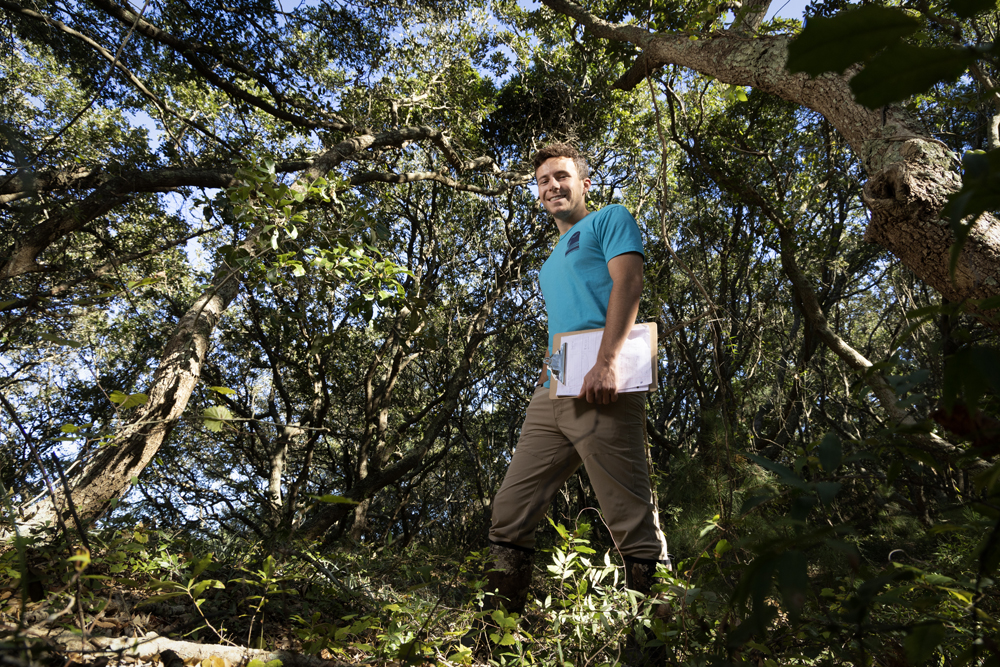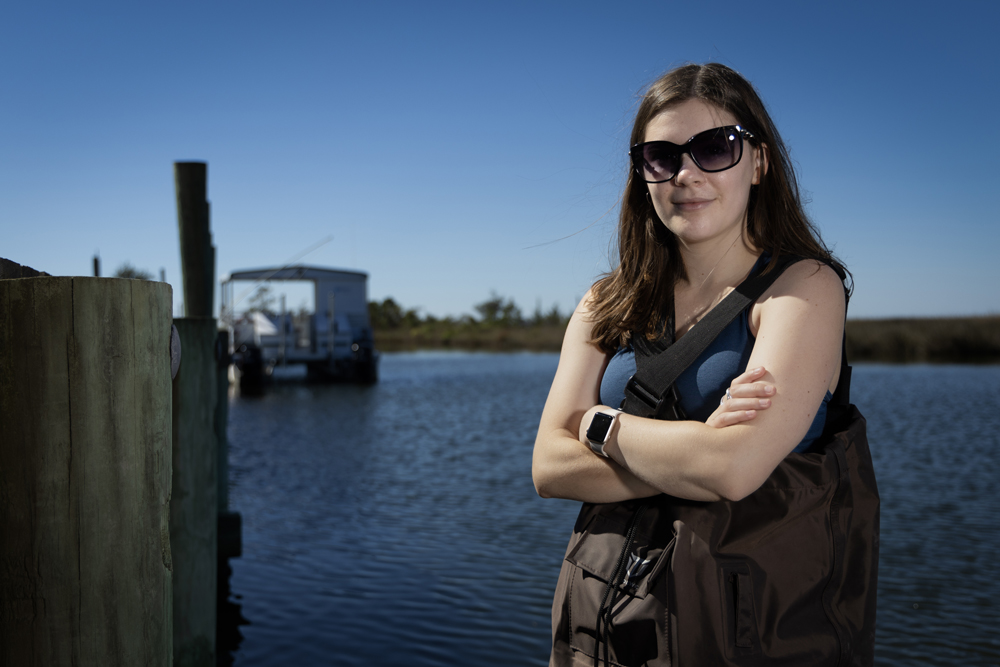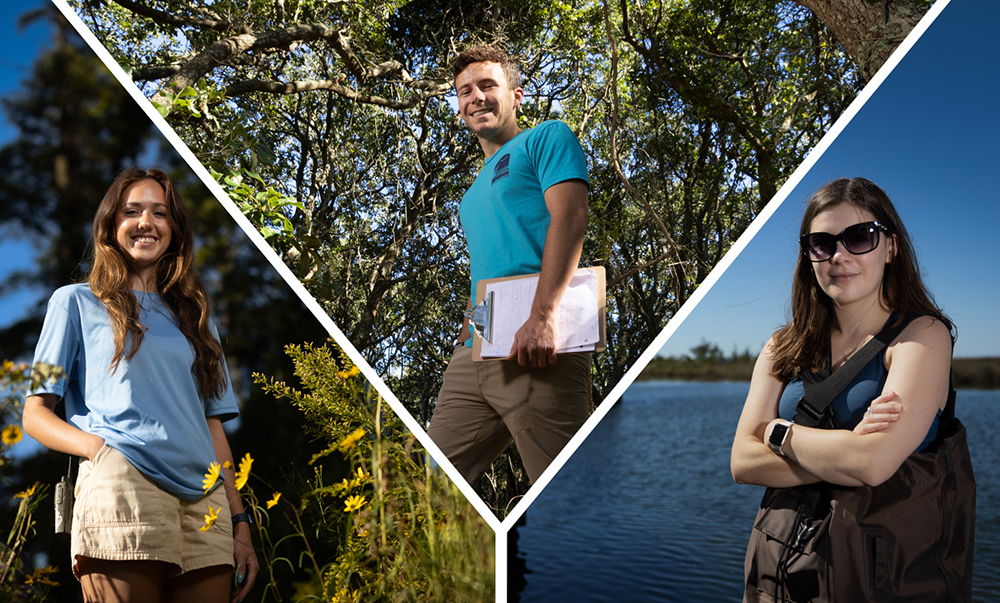Listen to the story:
On a fall morning in 2023, Abigail Montes de Oca starts her day with a walk through the North Carolina Aquarium on Roanoke Island. She passes sting rays skating along the sandy bottom of a shallow pool, soft pink jellyfish drifting across a floor-to-ceiling fish tank, and a life-size replica of a giant megalodon jaw. Then, she heads out the front door and walks across the lawn to the back of the property, where a series of gravel paths snake through patches of waist-high wildflowers.
Welcome to the aquarium’s Pollinator Habitat Garden.
This is where Montes de Oca completed her internship for the Outer Banks Field Site program. Each fall, the program hosts a group of UNC-Chapel Hill undergraduate students at the Coastal Studies Institute in Wanchese, North Carolina, where they spend the semester taking classes in ecology and environmental policy, engaging in research, and completing internships with local organizations.
The internships align with each student’s field of study. Montes de Oca was one of three biology majors last year, and her project assessed pollinator health. The other two — Drew Huffman and Ella Hennessey — also completed internships focused on biodiversity across the islands.
“Biodiversity is essentially the variety of species and population sizes that inhabit a certain ecosystem,” Huffman says.
Huffman worked with the N.C. Coastal Reserve and the National Estuarine Research Reserve to monitor reptile and amphibian populations at Buxton Woods on Hatteras Island. Hennessey spent her semester counting fish for a project assessing fish populations within artificial reefs at the Coastal Studies Institute.
From hands-on field research to data analysis, each student gained an intimate perspective on the importance of species preservation, community engagement, and the beauty of the ecosystems that inhabit the Outer Banks.
Monitoring monarchs at the North Carolina Aquarium

Abigail Montes de Oca completed her Outer Banks internship with the North Carolina Aquarium on Roanoke Island. (photo by Alyssa LaFaro)
During Montes De Oca’s internship at the North Carolina Aquarium, the Carolina sophomore worked with horticulturist Rachel Veal on the Monarch Larva Monitoring Project. This involved searching for larvae on milkweed plants in the pollinator garden and observing their development over time. Once they reach maturity, the researchers attempt to catch and tag them to track their migration to Mexico for winter.
To practice her tagging skills at the start of the semester, Montes de Oca used a net to capture cloudless Sulphur and gulf fritillary butterflies — species more commonly found in the garden.
“There was definitely a learning curve,” she says with a laugh. “I failed to catch many in the net, and it was pretty nerve-wracking once I did finally get one.”
After gently removing a butterfly from the net, Montes de Oca would hold its thorax and place a small sticker with tracking information on the discal cell on the edge of the forewing. On monarchs, this cell looks like a mitten.
But Montes de Oca had few opportunities to put her newfound abilities to good use.
“This season at the aquarium, we had some of the lowest monarch larvae numbers they’ve ever seen,” she shares. “Many times, we would go out and spend a couple hours inspecting every leaf of these plants and find nothing — and that was discouraging. It was kind of hard to stay focused on what we were trying to do when it felt like we were collecting no new data.”
While Montes de Oca was disappointed by the low monarch numbers, the project was a good reminder that a lack of data has purpose, too.
“There’s a reason this is happening, and if the trend continues, it will fit into a bigger picture later on and won’t seem so random,” she says. “It’s still important to collect this data if even there’s not much.”
Searching for swamp creatures in Buxton Woods

Drew Huffman completed his Outer Banks internship with the N.C. Coastal Reserve. (photo by Alyssa LaFaro)
The 90 minutes of ocean views that filled Drew Huffman’s drive on the first day of his internship last September didn’t prepare him for what awaited him at his field site. The Buxton Woods Reserve is a maritime forest and shrub swamp, so it’s often wet from changing ocean tides. This means it’s a popular hangout spot for mosquitoes — so many that the Carolina senior had to wear a neck and face net to avoid getting eaten alive.
“It’s great for the frogs, but not for us,” Huffman says with a laugh.
For the semester, Huffman was paired with Erik Alnes, northern sites manager at the N.C. Coastal Reserve, to monitor reptile and amphibian populations. Each Monday, they spent two hours exploring the woods in search of the coverboards — large sheets of wood or metal — and PVC pipes that the researchers set up earlier in the year to attract their study subjects. These materials create cool, moist habitats that reptiles and amphibians are drawn to.
Huffman recorded the creatures inhabiting each site. He saw a lot of southern leopard frogs, green tree frogs, and yellow-bellied sliders — a colorful land and water turtle — and encountered a few snakes, including cottonmouths, black racers, and eastern ribbons.
“One day, we went out with a herpetologist, somebody who studies amphibians and reptiles,” Huffman describes. “And he picked up this ribbon snake because he knew it wasn’t venomous and that its fangs were too small to break his skin. It probably struck him five or six times. It just blew my mind how brave and comfortable he was.”
Back on Roanoke Island, Huffman dug into his data to look for trends. As temperatures decreased, for example, so did the number of reptiles and amphibians found at the study sites.
This was Huffman’s first foray into research. Before coming to the field site, he admits he was more focused on pursuing a career in medicine — but his time at the Outer Banks changed his mind.
“There are so many more opportunities than I knew about in terms of a career path in environmental science,” he says. “Engaging with the community here has been such a huge part of that. Getting to hear their perspectives, how things are changing, and how important it is that we protect these natural resources is super cool.”
Assessing fish populations in the Pamlico Sound

Ella Hennessey completed her Outer Banks internship with the Coastal Studies Institute. (photo by Alyssa LaFaro)
Ella Hennessey has perfected the art of counting fish.
Last semester, the Carolina sophomore spent hours reviewing video footage of fish congregating around artificial reefs in the Pamlico Sound for a project with Jim Morley, a biologist at the Coastal Studies Institute.
“The reefs are really interesting,” Hennessey says. “They are made of construction debris, oyster shells, limestone piles, and reef-balls, which look like giant cement whiffle balls. Just a few weeks after putting them in the water, soft corals and all these little organisms start growing on them, and they turn into an ecosystem.”
Morley and his team want to know how and where fish inhabit the reefs. They have eight monitoring sites across the Pamlico Sound, and Hennessey was able to visit one about three hours away from the institute near a coastal town called Oriental.
A typical day in the field starts at 6 a.m. to make the long drive. Upon arriving, researchers hop in a boat and head deep into the sound. Across 26 sampling points, they use a sophisticated sonar device, sometimes called an acoustic camera, that releases sound pulses to identify fish location, size, and number. They also measure salinity, temperature, pH, water clarity, and dissolved oxygen.
While they spend just a few minutes at each point, visiting all 26 takes several hours.
“I learned to deal with being uncomfortable on the water,” Hennessey admits. “I also helped out with a grad student’s thesis project, and I think we were out on the water for 10 to 12 hours maybe. You just sort of shut your mouth, put your sunglasses on, get in the water, stick through it, and don’t think about how much time is left.”
But most days during her internship, Hennessey could be found in the lab counting fish on a computer monitor — which isn’t as simple as it seems.
“Your eyes have to adjust to these weird sonar videos,” she says. “At first it’s like, Is that a rock or is that a fish? I was counting the maximum fish, so you have to watch the whole video, and then you have to find the frame that has the most fish in it.”
Hennessey believes this project has prepared her for the research she’ll conduct this spring and summer in the lab of Carolina biologist Carol Arnosti, who is leading a 21-day research cruise in the Atlantic Ocean to collect and analyze microbes within deep sea water. Hennessey will work as an undergraduate researcher on the ship.
“It’s been a crazy semester, but so much fun,” she says. “It’s been a great experience to figure out the things I do and don’t like. While I still have no clue what I want to do after college, I’ve been exposed to all these different people and jobs, and I know at some point something will click.”


